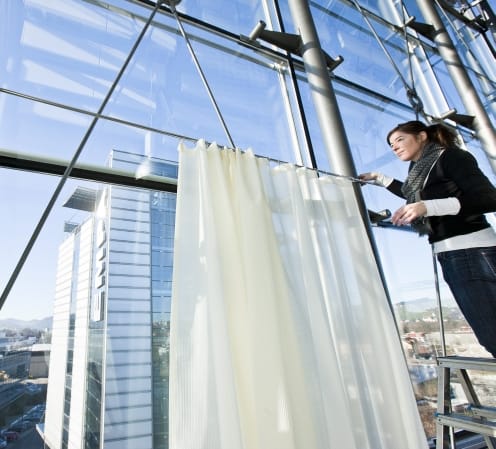
Researchers in Switzerland have developed a new kind of lightweight curtain that can absorb sound waves while still letting light through. They say it is ideal for soaking up noise in offices, conference rooms or other places where natural light is needed.
Noise can be a major source of irritation at work or in the home, reducing productivity and making it hard to relax. Unfortunately, many of the materials used in interior design, such as glass and concrete, are what are known as acoustically hard. These materials reflect sound waves and so do not reduce levels of noise within a room.
On the other hand, acoustically soft, or porous, materials absorb a portion of the sound energy that strikes them. The fraction of energy absorbed depends on the frequency of the sound. Absorption occurs because air moving through such materials is slowed down by friction, which causes some of the sound energy to be converted into heat.
Lightweight and translucent
Usually, sound-absorbing materials are placed on the floor or ceiling, for example in the form of carpet or special kinds of tile. In places where the floor or ceiling cannot be modified, curtains can be used instead. But these are generally heavy and opaque. The new curtains, on the other hand, are lightweight and translucent.
The material for the curtains was designed using a computer model developed by researchers at Empa, the Swiss Federal Laboratories for Materials Science and Technology. The model was used to predict the acoustic behaviour of a variety of curtains, with properties such as a curtain’s size, porosity and mass per unit area altered to maximize sound absorption over a wide range of frequencies. Textile designer Annette Douglas then used the model to build an actual material – weaving together four or five different modified polyester yarns in such a way as to maintain the absorption characteristics while also ensuring fire resistance and light transmittance.
The material was then put to the test inside Empa’s reverberation chamber – a room in which sound waves are made to diffuse uniformly or randomly. With the curtain positioned 15 cm from a wall, the researchers found it could absorb up to five times as much sound as typical lightweight curtains. At low frequencies of about 200 Hz, it absorbed no more than about a fifth of the incident sound energy. However, at frequencies above 500 Hz (human ears having a maximum sensitivity between about 3000–4000 Hz) the material absorbed around three-quarters of the incident sound energy.
Astonished acousticians
“Acousticians are pretty astonished when they see the readings we are achieving with the new curtains,” says Kurt Eggenschwiler, head of Empa’s acoustics/noise-control division.
The curtains have been made into commercial products by silk weavers Weisbrod Zürrer and are now entering the German and Swiss markets. According to Douglas – whose company Annette Douglas Textiles sells the products – the curtains cost about 40% more than “a regular sheer fabric produced in Switzerland”.
Ken Gilbert of the National Center for Physical Acoustics at the University of Mississippi in the US thinks that the new curtain will “be well received and have a strong market”. He points out that sound-absorbing materials are generally used to reduce noise coming from objects within the room in question, whereas the new material will also be to reduce noise coming from outside through open windows. “This is an added bonus,” he says.



